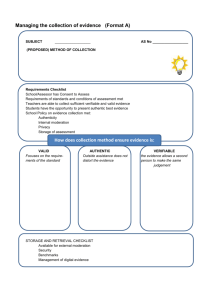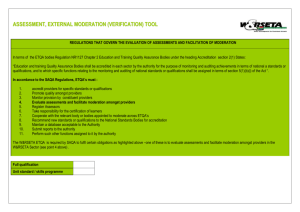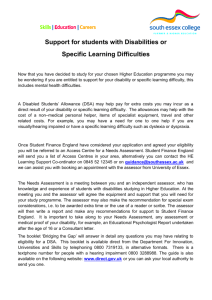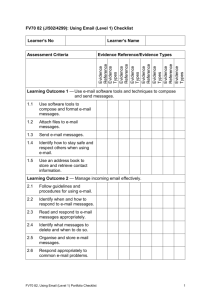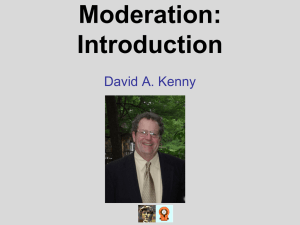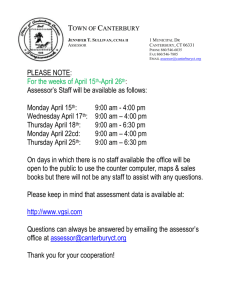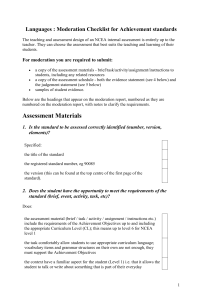Addendum A – Assessment Plan
advertisement
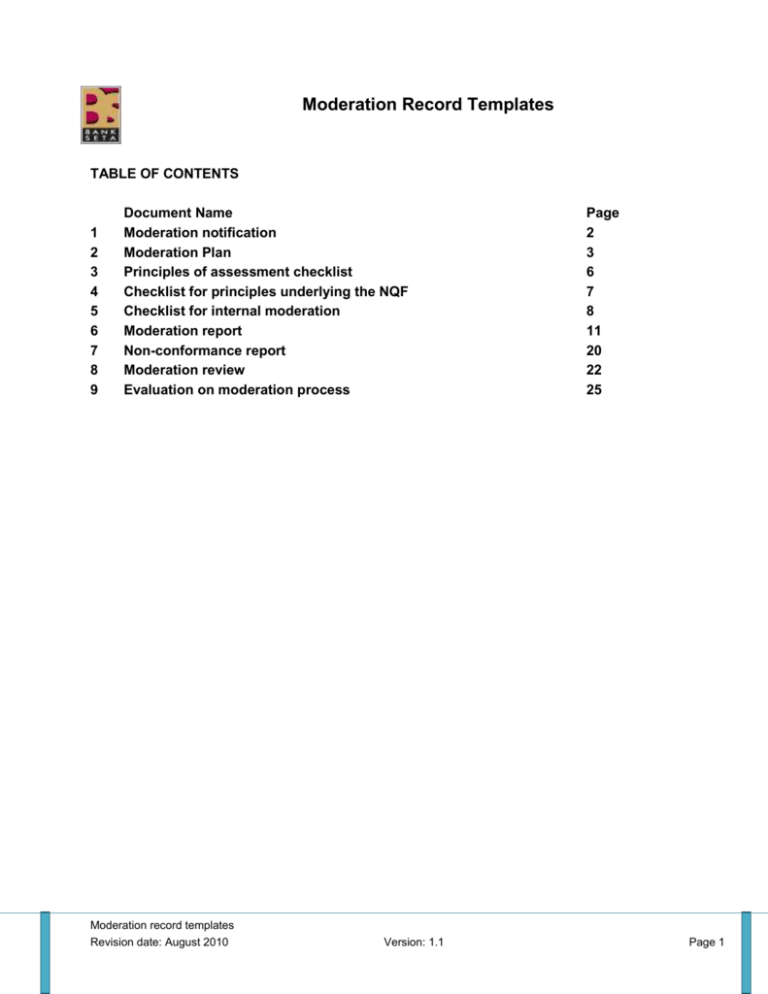
Moderation Record Templates TABLE OF CONTENTS 1 2 3 4 5 6 7 8 9 Document Name Moderation notification Moderation Plan Principles of assessment checklist Checklist for principles underlying the NQF Checklist for internal moderation Moderation report Non-conformance report Moderation review Evaluation on moderation process Moderation record templates Revision date: August 2010 Version: 1.1 Page 2 3 6 7 8 11 20 22 25 Page 1 Notification of Moderation To: From: Tel No: E-mail: Date: Notification of Moderation This memorandum serves to notify you that the assessment with the below mentioned details will be moderated for Quality Assurance purposes, to ensure that assessments are conducted according to quality assurance processes. Particulars of Assessment: Learner: Unit standard no: Date: Time: Venue: Thank you for your co-operation Moderator: Moderation record templates Revision date: August 2010 Version: 1.1 Page 2 Moderation Plan Assessor’s information Name: Registration number: Employee number: Department: Telephone number: E-mail: Moderator’s information Name: Registration number: Employee number: Department: Telephone number: E-mail: Date of previous Moderation visit: Date of current Moderation visit: Venue: Moderation process Each moderation visit is carried out in exactly the same manner to ensure fairness, validity and reliability of the moderation process. Each moderation visit will cover the following moderation activities: 1. Evaluation of all assessment documents. This will ensure that the documentation has been completed in accordance with the company’s policies and ETQA requirements. It will also ensure that it is an accurate reflection of the assessor and learner’s competence. 2. Questioning the assessor to ensure that the process was fair, valid and reliable. 3. Verification. 4. Feedback to the assessor. Moderation record templates Revision date: August 2010 Version: 1.1 Page 3 Unit standard name and code: Specific outcome Assessment Criteria number Moderation record templates Revision date: August 2010 Moderation Activities Moderation Techniques Version: 1.1 Moderation date Page 4 Feedback Date Assessment Design Obtain US applicable to the job being assessed. Analyse US to see if fit for purpose for the job assessed Obtain copies of the Assessor Guide Assess the appropriateness of the assessment methods and tools used Assessor guidelines – is the instructions clear and the model answers provided Assessment plan in place for the assessment Assessor ability for unit standard being assessed Assessment activities before assessment Documentation used by the assessor. Pre-Assessment meeting, which includes the following: 1. Logistical arrangements with the candidate and relevant parties 2. Declaration letter agreeing to be assessed 3. Agenda 4. Minutes of meetings 5. Documents discussed with the learner which include: roles of assessor and learner, The appeals procedure, identified barriers of any kind, the US, implications of outcomes-based assessment and linkage to job profiles, discussion of the assessment and moderation process 6. Participation from the learner 7. Check for authenticity of all activities signed and dated 8. Assessment plan & learning guide distributed and discussed 9. Special needs noted Assessment activities during assessment Environmental issues were taken into consideration i.e. work-site safety, environment safety, any applicable legislation. Assessment was conducted as per the assessment plan without deviating from the plan. Evidence was collected in a valid, consistent and fair manner, to be able to make the judgments. Moderation record templates Revision date: August 2010 Version: 1.1 Page 4 Assessment activities after assessment Letter of gathering unobtrusive evidence. Evidence is evaluated and judgments made in terms of the outcomes and assessment criteria. Allowances for unforeseen events, breakdowns and changed circumstances were taken into consideration VACS analyses were applied. Feedback provided to candidate and other relevant parties. Evaluation of the assessment process was received from the learner. SWOT analyses were conducted. Where applicable the appeals process was followed as per the policy. Assessment documentation Documentation to assess: Evidence checklist Assessment Record sheet Assessment Appeal Application Form Additional evidence provided by learner as well as assessor Moderation Methods Statistical Moderation Panel Moderation Group Moderation Moderation by inspection Consensus Moderation Institutional Moderation Intrinsic Moderation Special Needs: Issues to be addressed: Moderation record templates Revision date: August 2010 Version: 1.1 Page 5 We the undersigned, hereby agree to be available and the availability of the assessment documentation and learners as listed in the moderation plan. Assessor: Date: Moderator: Date: Supervisor/Manager: Date: Moderation record templates Revision date: August 2010 Version: 1.1 Page 6 Checklist for Principles of Assessment IF NO, state how the neglected principle can be achieved in future: Example of an Assessment Report, if not meet one of the above principles: Thank you for submitting your portfolio for evaluation. Your Moderating Instrument is of high quality, and you have adhered to most of the assessment criteria. However, additional evidence is necessary to address some of the assessment criteria. Please read through the notes made under each Outcome and submit the evidence as soon as possible to enable me to complete the evaluation of this portfolio. Yes 1. Appropriate The method of assessment is suited to the performance being assessed. 2. Fair The method of assessment does not represent any barriers to achievements related to the evidence. 3. Manageable The methods used make for easily arranged, cost effective assessments. 4. Integration Evidence collection is integrated into the work or learning process where this is appropriate and feasible. 5. Valid The assessment focuses on the requirements laid down in the Standard; i.e. is fit for purpose. 6. Direct The activities in the assessment mirror the conditions of actual performance as closely as possible. 7. Authentic The assessor is satisfied that the work being assessed is attributable to the person being assessed. 8. Sufficient The evidence establishes that all criteria are met and that performance can be repeated consistently. 9. Systematic Planning and recording is sufficiently rigorous to ensure that assessment is fair. 10. Open Learners can contribute to the planning and accumulation of evidence. Learners understand the assessment process and criteria that apply. 11. Consistent The same assessor would make the same judgement again in similar circumstances. The judgement made is similar to the judgement that would be made by other assessors. Moderation record templates Revision date: August 2010 Version: 1.1 No Page 7 Checklist for underlying principles of NQF Integration Relevance Credibility Coherence (Rationale) Flexibility Standards Legitimacy Access Articulation Progression Portability Recognition of Prior Learning Guidance of Learners Belong together – not need to for10 plans; e.g. does it make sense what they have integrated (CCFO’s). Check the Unit Standard to be assessed. Registered with SETA, busy with assessment and process. Aware of what is going on, does it make sense in the way they have assessed; e.g. assessed knowledge first, simulation and then demonstrate. Can move out of the lines (look at re-assessments will it be problem) Tests especially – not same tests. SAQA’s principles are the benchmark. What was supposed to be assessed – was it done; was it real (authenticity). Literacy, Level NQF? Learning assumed to be in place. Outcome is the head. Follow the link to the end of the outcome – assessment of Unit Standard, how it fits together. 2 fold 1. Where to now after assessment – what is the next step. 2. Can be in the beginning or at the end. Take it with the learner to somewhere else. Be tougher in this area (VACS), check evidence carefully generated by the learner not assessor. Pre-assessment. Conduct. Feedback. Moderation record templates Revision date: August 2010 Version: 1.1 Page 8 Checklist for the Internal Moderation Process Fairness Y N Y N The learner was prepared for the formal (summative) assessment(s). Assessment procedures were open and well explained to the learner during the assessment-planning phase. There was no discrimination against a learner based on gender, race, age, disability and social class. The learner was given the opportunity to lodge an appeal. Assessment approaches, methods, instruments and materials were chosen to accommodate learners’ differences and special needs. The learner was assessed against the unit standard and the learner’s work was not compared with other learners. The appeal mechanisms and re-assessments were accessible to the learner. Validity The assessment measure what it is suppose to measure in relation to the unit standard and assessment criteria. The procedures, methods, instruments and materials matched what is suppose to be assessed. An assessment guide was used to conduct an assessment against this unit standard. The assessor stated clearly what outcome(s) were being assessed. The assessor used an appropriate type, or source, of evidence. The assessor used an appropriate method of assessment. The assessor selected an appropriate instrument of assessment. The evidence form was a reliable and objective source The evidence can be supported The assessment did not assess more or less than what is required in the unit standard. Moderation record templates Revision date: August 2010 Version: 1.1 Page 9 Reliability Y N Y N The assessor was familiar with the assessment methods, assessment instruments and the application environment. The assessment instruments were clear, consistent and unambiguous. The assessment activities were administered in the same way for all the learners. The assessment results were not perceived to have been influenced by variables such as: - different assessors applying different standards; - assessor stress and fatigue; - not enough evidence gathered; - assessors bias in terms of the learner’s gender, ethnic origin, sexual orientation, religion, like/dislike, appearance and such likes. Assumptions about the learner did not influence the assessors judgments. The assessment criteria and guidelines for the unit standard were adhered to. The Assessor has knowledge of the learning field (technically competent). The assessment guide provided the learner and assessor with a clear indication of competent performance. The recording of assessment results was clear and systematic. Practicability The assessment focused on gathering evidence that occurred naturally in the workplace. Financial resources, time equipment and facilities were considered for a simulation/role play. Costs, facilities, equipment and time were considered when the assessment was planned. Opportunities for assessing the learner outside the learner’s current work environment were considered in terms of the cost and practicality. Tools used allowed for the necessary evidence to be collected. There was room for an appeal. Moderation record templates Revision date: August 2010 Version: 1.1 Page 10 Practicability, continue Y N The assessment methods used were: - Appropriate: A variety of assessment methods were used to ensure that the assessment methods were suited to the performance being assessed. - Integrated with work or learning - Manageable: The methods used to collect evidence were straightforward, readily arranged and did not interfere unduly with learning or work. The assessment was: - Consistent - Systematic - Open The Evidence was: - Direct: Evidence was as direct as practicable, collected from activities that were as similar as possible to the conditions of the actual performance. - Authentic: The assessor was confident that evidence is attributable to the person being assessed, that outside assistance is not distorting the assessment. - Sufficient: The quality and quantity of evidence was established with confidence that the assessment criteria have been met and that performance to the required standard was repeated with consistency. Records are kept. Records are accurate. Records are stored in a safe place but are accessible. Reports were compiled on the assessment conducted. The Assessment was performed according to the requirements/specifications of the appropriate SETA/ETQA. Feedback was provided. Reviews were conducted on the assessment process/procedures. Gaps were identified and appropriate measures were taken, e.g. re- training of assessors. Moderation record templates Revision date: August 2010 Version: 1.1 Page 11 Moderation Report Assessor’s information Name: Registration number: Employee number: Department: Telephone number: E-mail: Moderator’s information Name: Registration number: Employee number: Department: Telephone number: E-mail: Date of previous Moderation visit: Date of current Moderation visit: Venue: Details of learner(s) moderated Name Department Moderation record templates Revision date: August 2010 Employee number Telephone number Version: 1.1 Unit standard qualification Page 12 Assessment documentation Was the assessment documentation available, if not, state the reasons No Yes Moderation methods used Evidence required from the evaluation documents 1. Assessment Plan Personal details of the assessor and the learner have been completed. Yes No The unit standard(s) that the learner is to be assessed against has been identified. The unit standard(s) that the learner is to be assessed against has been identified. Information that the assessor must give the learner to prepare the learner for the assessment is completed. Any special notes regarding the learner have been included. If there are not any special needs this must be stated. Moderation record templates Revision date: August 2010 Version: 1.1 Page 13 The assessment activities as indicated in the assessor and learner guidelines have been correctly identified. 1. Assessment Plan; continue The assessment methods that the assessor will use to collect evidence for that particular assessment activity as indicated in the assessor and learner guidelines have been circled. Yes No Yes No The dates on which the assessments will take place has been completed. This may be for a period of time if the registered assessor is collecting naturally occurring evidence from the workplace. The date when the registered assessor will give feedback to the learner has been identified. The assessor and the learner have signed the Assessment Plan. 2. Assessor Guide All the bullets listed under each assessment criteria have been ticked off. All assessment criteria have been covered. Different assessment occasions have been clearly indicated. Different assessment occasions have been clearly dated. Moderation record templates Revision date: August 2010 Version: 1.1 Page 14 Comments on the assessment have been included. Clear model answers are given for the assessment. 3. Evidence checklist All the personal details of the learner and the assessor have been completed. Yes No The place where the assessment(s) took place has been indicated i.e. on-thejob or off-the-job. The date(s) on which the assessment(s) took place have been indicated. The date(s) indicated on the evidence checklist are the same dates as the dates reflected in the assessor guide. The corresponding colour of pen has been used for recording on the guidelines for the assessor and the evidence checklist. Both learner and assessor have signed the document after each assessment occasion. Assessment methods have been identified. Results for each assessment occasion are indicated and dated. Appropriate judgements are cross-referenced with assessor guide. Moderation record templates Revision date: August 2010 Version: 1.1 Page 15 Dates correspond with dates indicated in the assessor guide. Provide comments about the assessment occasion. Provide details about the evidence the assessor has collected. Sufficient and specific notes were taken in order to provide comprehensive feedback to the learner. 4. Assessment record sheet All the personal details of the assessor and the learner have been completed. Yes No All the assessment criteria are ticked off and cross referenced with the evidence checklist to ensure that it corresponds. All the specific outcomes are ticked off. Assessment methods have been identified. The date on which the learner demonstrated competence against each assessment criteria and each specific outcome has been completed. Crossreference with evidence checklist to ensure that the same date is indicated. Moderation record templates Revision date: August 2010 Version: 1.1 Page 16 Both the learner and the assessor have signed the assessment record sheet indicating that the learner has demonstrated competence against the said unit standard, that the record is authentic and that the assessment has been done in a fair, valid and reliable manner. The Unit Standard and assessment documentation was appropriately used, if not, explain why. 5. Assessment documentation The following documentations were available: Evidence checklist Record sheet Appeal application form Yes No Additional evidence provided: Logistical arrangements Declaration letters Agenda Minutes of meetings Signatures for policies recorded SWOT analysis Learner evaluation Evidence required from questioning the learner 1. How did the assessor plan the assessment (when and where it took place)? 2. Who was involved in the planning process? 3. Was the purpose of the assessment discussed? Moderation record templates Revision date: August 2010 Version: 1.1 Page 17 4. Were there any special needs that had to be taken into consideration? 5. Was the unit standard discussed with the learner and agreed upon? 6. Which assessment methods did the assessor use during the assessment? 7. Was the learner involved in the discussion on the type of evidence to produce for the assessment? 8. Which activities did the assessor use to collect evidence? 9. Who explained the assessment process, procedure, purpose, methods, review procedure and documents to the learner? 10. Who discussed the learner’s learning requirements, prior knowledge and experience with him/her? 11. Who made the logistical arrangements with you? 12. Were you provided with the appropriate documentation, if yes what documentation? 13. How did the assessor discuss the learner guidelines with the learner? 14. How did the assessor ensure that the learner understands what is expected of him/her? Moderation record templates Revision date: August 2010 Version: 1.1 Page 18 Feedback 15. How did the assessor give feedback to you? 16. When did the assessor give feedback to you? 17. Where did the assessor give feedback to you? 18. How did the assessor ensure that the feedback given was specific, constructive and sensitive? 19. Did the assessor ensure that you understand the feedback? If yes, how did s/he ensure that you understand the feedback? 20. How did the assessor plan the next steps with the learner? Evidence required from questioning the Assessor 1. How did the assessor plan the assessment with the learner (when and where did it took place)? 2. How did the assessor prepare the learner for the assessment? 3. How did the assessor conduct the assessment (period, where, how and what methods were used to collect the evidence)? Moderation record templates Revision date: August 2010 Version: 1.1 Page 19 4. When and where did the assessor give feedback to the learner? 5. Was the feedback timeous and in an appropriate environment? 6. How did the assessor determine if the evidence collected correspond to the assessment criteria? Moderation record templates Revision date: August 2010 Version: 1.1 Page 20 General 1. Has the assessment been conducted according to the Rules of Evidence (VACS)? Yes No 2. Does the assessment process adhere to the national assessor unit standard? (Please motivate your answer) 3. Have the issues stemming from the previous moderation report been addressed? (Please indicate how. 4. State your conclusion about the competence of the assessor based on the national assessor unit standard. 5. Summarise the feedback to the assessor about the assessment practice. Declaration of understanding I hereby declare that I agree with the outcome of the internal moderation process, and that the moderation report is clear to me. I am satisfied that the written feedback given to me was relevant, and done in a constructive manner. I accept the report and have no obligations to this particular internal moderation Assessor: Date: Internal Moderator: Date: ETQA Representative: Date: Moderation record templates Revision date: August 2010 Version: 1.1 Page 21 Non-conformance Report Assessor’s information Name: Registration number: Employee number: Department: Telephone number: E-mail: Moderator’s information Name: Registration number: Employee number: Department: Telephone number: E-mail: Date of previous Moderation visit: Date of current Moderation visit: Venue: Moderation record templates Revision date: August 2010 Version: 1.1 Page 22 Type of Non-conformance Unfair assessment (no consistency/discrimination) Invalid assessment (not reach same outcome) Unreliable assessment (evidence produced not relevant/not sufficient) Unethical behaviour (ethics/professionalism) Unfair barriers to assessment Contravention of the assessment process Assessor not technically competent Learner not technically competent Contingency plans influenced assessment Inability of the assessor to make judgment based on SME knowledge Other (Stipulate) The reason for the type of non-conformance is motivated. Assessors reason(s) for non-conformance is noted. Assessor: Date: Internal Moderator: Date: Moderation record templates Revision date: August 2010 Version: 1.1 Page 23 Moderation Review Strengths 1. The right moderation methods were used for the specific assessment as it could measure fairness, validity, reliability and practicability. 2. The right moderation techniques were used for the specific assessment. 3. The moderation process, were understood by all parties, (clear and precise). 4. The moderation documentation in use is sufficient e.g. moderation plan, moderation report, non-conformance document as it covered all the necessary aspects to moderate on. 5. The moderation system and processes allows for manageability and ability to make judgments on the quality and validity of assessment decisions. 6. List good practices that were identified during the assessment. 7. The process allowed for unforeseen events to be built into the moderation process. 8. Specify any other strengths Weaknesses 1. The right moderation methods were not used for the specific assessment, as it could not measure fairness, validity, reliability and practicability. 2. The right moderation techniques were not used for the specific assessment. 3. The moderation process was not clear to the assessor due to language and terminology, as well as the inability to explain the moderation scope to the assessor. 4. The moderation documentation in use is not sufficient e.g. moderation plan, moderation report, non-conformance document as it does not cover all the necessary aspects of the moderate process. 5. The moderation system and processes did not allow for manageability and the ability to make judgments on the quality and validity of assessment decisions. 6. The process did not allow for unforeseen events to be built into the moderation process. 7. List bad practices identified in the moderation process. Moderation record templates Revision date: August 2010 Version: 1.1 Page 24 8. List any other gaps identified in the moderation process. Opportunities List any opportunities or improvements that can assist to make the moderation process ran smoother, save time, cut costs or add value for all parties that forms part of the process. Threats Rand Value Look at the cost of moderation Down time of the learner per hour (average salary per hour) Down time of the assessor per hour (average salary per hour) Down time of internal moderator per hour (average salary per hour) Cost of the venue if applicable Cost of the equipment if applicable Down time of any other party, that formed part of the assessment (average salary per hour) Any other cost that formed part of the moderation Total cost of the moderation Moderation record templates Revision date: August 2010 Version: 1.1 Page 25 Note: All the aspects must be discussed and put forward for re-design purposes to the SDF and Moderation committee. Moderator name: Signature: Date: Moderation record templates Revision date: August 2010 Version: 1.1 Page 26 Assessor’s evaluation of the Moderation process Assessor: Moderator: Date: Unit standard: Answer the following questions: Yes No Please elaborate Was your moderator’s manner of interacting encouraging, and did it put you at ease? Was the moderation procedure clearly explained? Did the moderator discuss the moderation plan with you? Were you encouraged to participate in the moderation discussion? Were the questions asked relevant to the assessment conducted? Were all possible sources of evidence covered? Were you given clear, specific, sensitive and constructive feedback? In what manner were the moderator’s decision communicated to you? Did you agree with and feel satisfied with the moderation decisions? Were you given the opportunity to appeal in the event you were not satisfied? Was all appropriate documentation completed and signed? Assessor: Date: Moderator: Date: Moderation record templates Revision date: August 2010 Version: 1.1 Page 27
